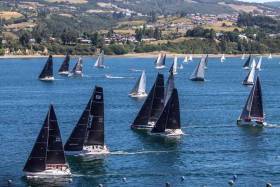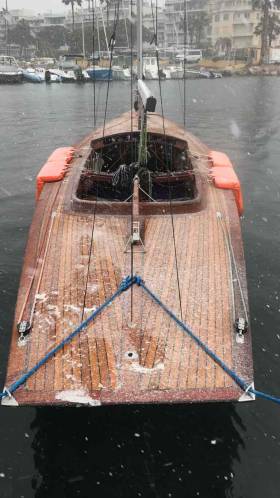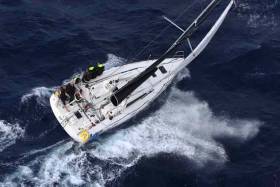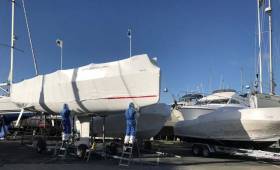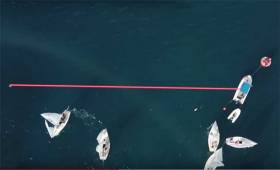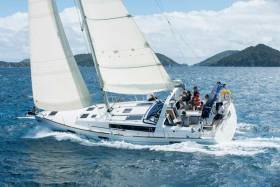Displaying items by tag: North Sails Ireland
Shane Hughes of North Sails Ireland left the cold Irish weather and the Northern hemisphere behind and headed south to Chile to compete in the biennial Regata Chiloe, one of Chile’s biggest and most prestigious regattas based around the beautiful southern island of Chiloe and the protected waters between it and the Chilean mainland. He had been invited by Pablo Anfruns and Rudolf Mijac to race with their team on the Melges 32 Red and here he describes the regatta and how North Sails Ireland developed a sail that led to a well earned win
Remarkably I was not the only Irish crew member. David Kennedy, an Irish expat now living and working in Santiago also hails from Dublin and had sailed with his father in Howth for years before heading south. Aside from being a great addition to the sailing team, David’s fluent Spanish also got me out of a few confused looks as I was giving direction in Spanglish to the Chilean lads, who in fairness to them were being very kind by pretending they knew what I was saying...
For those who have not experienced it, Melges 32 racing is fantastic fun. The boat is very powered up and can easily sail in as little as 4 knots of wind but really comes into her own in 15 knots plus downwind! Having had a break away from sailing the 32 for a few years, it reminded me what a truly special boat it is.
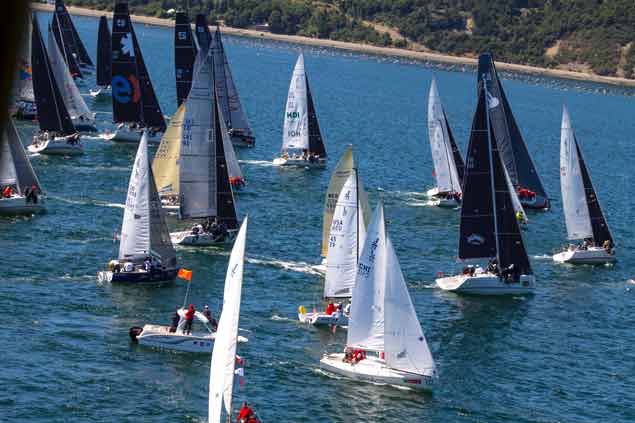 A fleet start from Castro in Leg one of Regata Chiloe, one of Chile’s biggest and most prestigious regattas
A fleet start from Castro in Leg one of Regata Chiloe, one of Chile’s biggest and most prestigious regattas
With only one other Melges 32 based in Chile right now (the newly acquired ‘Pepe Pato’ owned by Jose Tirado and Patricio Lopez) both boats were entered into the IRC division, not historically the Melges 32’s strong point with its big sail area and light displacement. So expectations were set firmly in pessimistic mode.
However, I underestimated how the format of the regatta along with the traditional winds for this event (light!) would play into the Melges’ strengths rather than its weaknesses. Thankfully Pablo, the helmsman, and co-owner had not overlooked these factors and this had formed his reasoning for purchasing the Melges 32. The regatta format is a mix of coastal races, with some inshore windward-leeward races. While the 32 would struggle a little on some of the inshore races, the longer coastal races actually suited the boat, especially with downwind or light upwind legs.
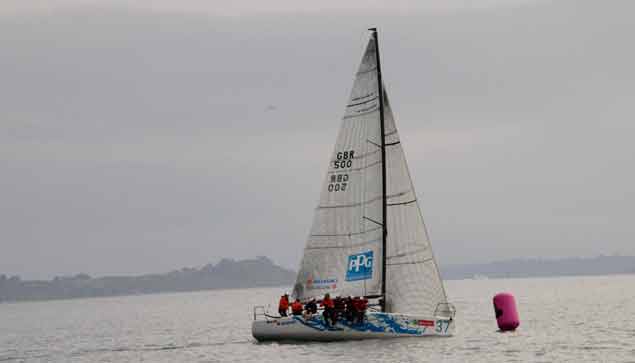 Shane Hughes onboard the Melges 32 ‘Red’ finishing the final coastal leg from Calbuco into Puerto Montt
Shane Hughes onboard the Melges 32 ‘Red’ finishing the final coastal leg from Calbuco into Puerto Montt
One area of concern in the lead up to the regatta was the absence of a Code Sail on the Melges 32. The boat had been almost exclusively raced in One Design configuration, with no need for any code sails, but this regatta format demanded a sail that would work on the reaching and super light wind legs. With the help of Dave Lenz in the North Sails UK design office, we set about designing an A Zero for the race.
With such a long bowsprit the Melges 32 does not offer the option to set a true Code Zero sail, as you can not generate the cable/luff tension required to furl the sail properly thus the choice of an A-Zero which is hoisted, deployed and retrieved the same as any other spinnaker onboard. This in itself presents a challenge because if you build the sail from too stiff a material (laminate or 3Di) the sail will be very difficult to hoist and recover through the fore-hatch but use a softer nylon material and the sail will not have the stability to retain its flying shape, especially as an IRC zero which requires a big mid girth (>75% of foot length).
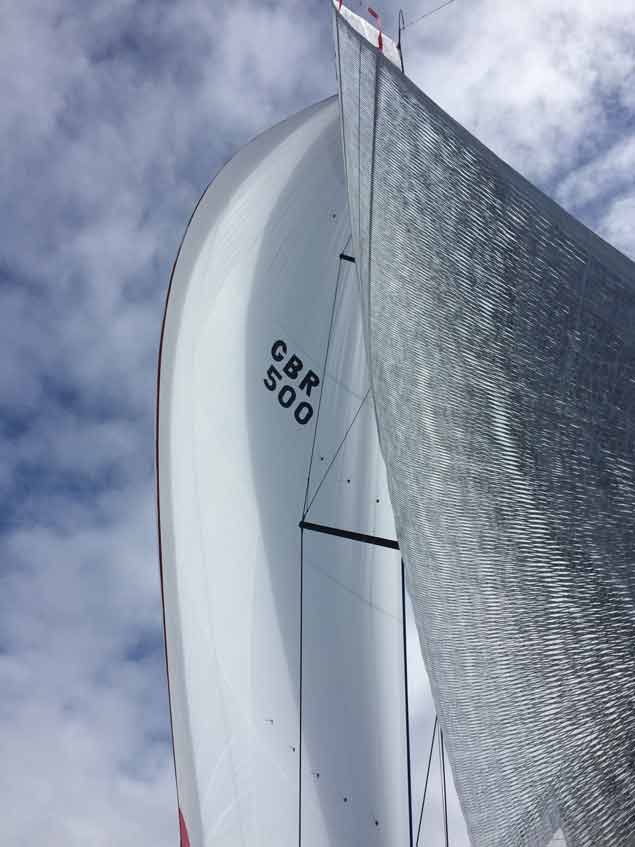 The new A Zero made from MaxiKote 200P
The new A Zero made from MaxiKote 200P
The compromise we struck was with Contender’s MaxiKote 200P. A great choice that produced a really stable sail shape that was easy for the crew to handle and work with. We also added North’s Velcro stop tabs which allowed us to roll the head and tack sections to make strong wind hoists easier and safer.
The sail performed superbly and actually won us a coastal race. When trailing our opposition Melges 32, we both sailed into a parking lot under a headland. In the light and tricky conditions they hoisted their biggest A2 Asymmetric and we hoisted our A Zero. From 100 meters behind we ghosted right by them, hit the new breeze first and won the race by some distance. The lesson learned, bigger is not always better especially in very light conditions.
We used a full North Sails inventory, which bar the new A Zero, was from 2011 when the boat competed in its last World Championships in Palma. The Main and J1/Light jib were 3DL, while the J2 and J3 were 3Di Endurance. The 2 Asymmetric we used were both made of AirX nylon. It really was a testament to the durability of both 3DL but especially 3Di that the sails had retained their flying shapes incredibly well. Granted they had not been used extensively in the interim but as you will see in the below pics, you would not guess they were 7-year-old sails.
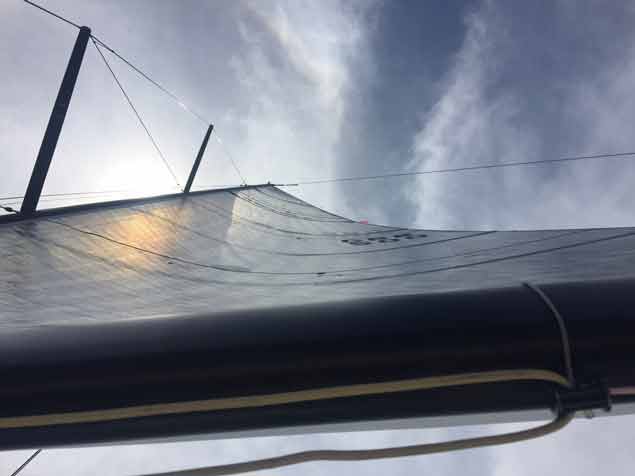 Our 7–year–old 3DL mainsail
Our 7–year–old 3DL mainsail
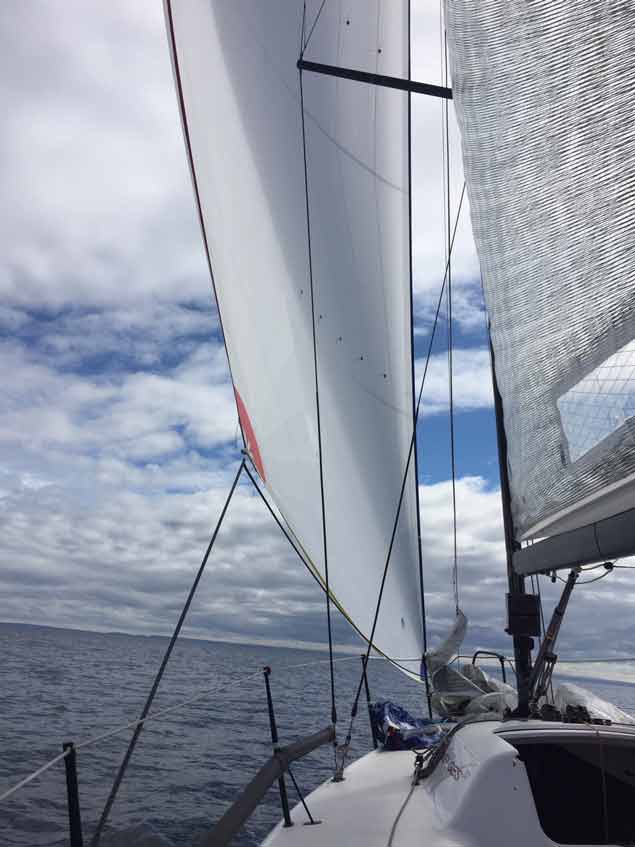 J1 jib in 8 knots. Flying shape still near its original marks
J1 jib in 8 knots. Flying shape still near its original marks
The 3DL sails were just beginning to show the first signs of de-lamination in high-density fibre areas and while this did not affect the performance of the sail at all, it does highlight what a huge advantage 3Di has over all of the ‘string’ sails from this perspective. The 3Di sails still looked brand new! No ill effects of being sat in the bag for that extended period. Unfortunately, the predominantly light winds meant they mostly remained in their bags, but the J1 held up superbly and ended up being the workhorse headsail for the regatta.
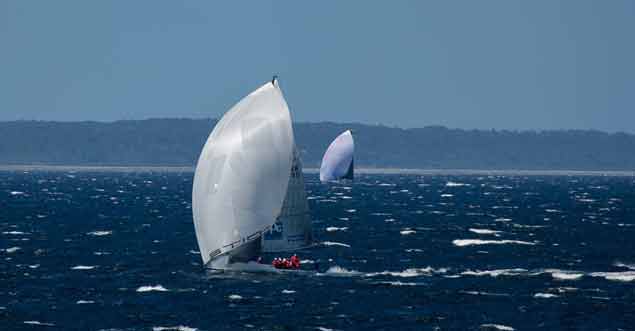 A 30NM downwind race in 25-30 knots saw Red finish ahead of most of the Soto 40’s on the water
A 30NM downwind race in 25-30 knots saw Red finish ahead of most of the Soto 40’s on the water
At the end of a thoroughly enjoyable weeks racing, both Melges 32’s ended up at the top of the leaderboard with our team taking the win. This surpassed expectations on all fronts for the owners, especially in their first year in the boat and helps promote the future growth of the Melges 32 in Chile. There was quite a lot of interest in the boat, with many observers very surprised with how fast the boat was, especially in the light conditions.
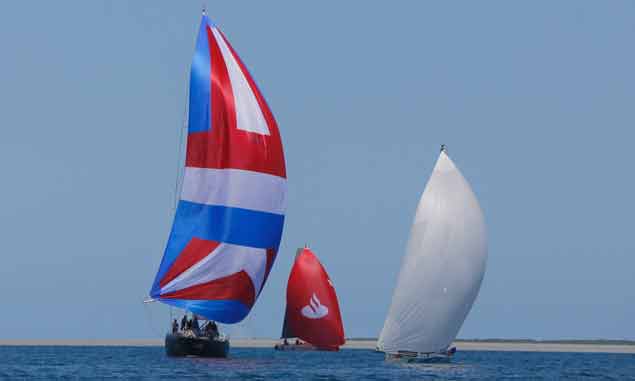 Light airs performance on the Melges 32 is pretty impressive. Above, finishing a 35NM coastal race in front of the Swan 68 ‘Sanhattan’ and most of the Soto 40’s.
Light airs performance on the Melges 32 is pretty impressive. Above, finishing a 35NM coastal race in front of the Swan 68 ‘Sanhattan’ and most of the Soto 40’s.
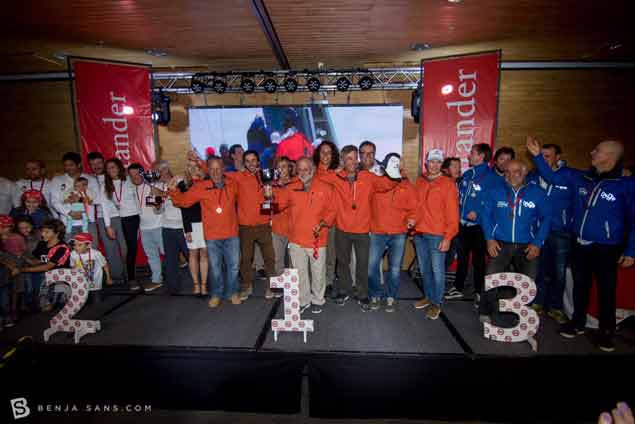 The Prizegiving. Red team left to right (Antonio Olavarria, JP Anfruns, Tomas Olavarria, Pablo Anfruns, Sébastien Briceno, Rudolf Mijac, David Kennedy, Shane Hughes)
The Prizegiving. Red team left to right (Antonio Olavarria, JP Anfruns, Tomas Olavarria, Pablo Anfruns, Sébastien Briceno, Rudolf Mijac, David Kennedy, Shane Hughes)
Find out what we can do to improve your sail inventory or get in touch with one of our experts below!
Snow on the Decks in Cannes for Dragon Grand Prix Regatta
There's an unexpectedly icy welcome for the Dragon fleet in Cannes, this week where the 'Beast from the East' is making its presence felt earlier in the South of France than it is in Ireland.
Unseasonably low temperatures and high winds will test the sailors over the next four days.
The Dragon fleet is assembled for the Grand Prix Regatta and they're expecting a tough few days.
Racing at the event is due to start tomorrow.
North Sails is a major supplier to the fleet and North Sails Ireland's Nigel Young will be racing in the regatta this year.
Caribbean 600 Winner Conor Fogerty Praises New North Sails
Last week's RORC Caribbean class winner Conor Fogerty, skipper of the Jeanneau Sunfast 3600 BAM!, has given a thumbs up to his new sail wardrobe from North Sails Ireland.
The race was very windy with Fogerty, the Irish Sailor of the Year, and his team emerging victorious after five days of wet and wild racing.
Fogerty has been working on his sail inventory with Maurice (“Prof”) O’Connell from North Sails Ireland since the first launch of “BAM! in 2015, notching up an OSTAR win and a previous class win in the C600 in 2016.
As Afloat.ie reported prior to the Caribbean 600, Fogerty took delivery of a new 3Di offshore mainsail for the event. Speaking after the race, the Howth Yacht Club skipper was fulsome in his praise of the new sails; “The new main is perfect, it was great to be able to totally rely on our sails, while boats around us dropped off due to sail failure. “BAM” returned to Antigua with a full intact wardrobe, and a class win which were are delighted with!”
This is the fourth season that North Sails Ireland have worked with Fogerty.
Most recently, in 2017, for his OSTAR class win, North Sails had supplied a new 3Di Code 2 jib and Radian no. 5 jib.
Congratulations to him and all his crew in keeping the ship together in which was a really tough, challenging race", O'Connell said.
BAM! Jeanneau Sistership Unveiled by MGM Boats in Dun Laoghaire Harbour
Just as the Jeanneau Sunfast 3600 success story that is BAM! celebrates yet another victory in the West Indies this weekend, a sister-ship is being unveiled in Dun Laoghaire Harbour by Irish Jeanneau dealers MGM Boats.
The new Dublin Bay arrival is a welcome addition to the Irish racing fleet that will most likely be seen first racing on the ISORA circuit, according to Afloat.ie sources. The first ISORA race of the season is a 40–mile coastal shake–down on April 21st.
The 2018 Irish Sea schedule runs right through to the end of September with 15 races in store thus giving plenty of time for the return of this week's Caribbean 600 class champion to line up against her new rival at a time when ISORA numbers are buoyant.
Afloat.ie understands the new 3600 is almost identical to BAM! with a sail wardrobe by North Sails Ireland. One big difference between the two boats, however, is the new owner has opted for a double wheel configuration instead of BAM's tiller arrangement.
The new boat is expected to be sailed mostly fully crewed or double-handed.
The boat, commissioned by MGM Boats this week, includes a spray finish antifoul by the boatyard.
North Sails Expert Reveals Tricks for a Better Yacht Race Start
The first two minutes of a race is arguably the most important. Those first two minutes will define where you start on the line, and how much space is around you to accelerate. This makes starting one of the hardest skills to master in sailboat racing. Good news is there are a few tricks that can make starting much easier. These tricks focus on executing a start that is low-risk and has a high-reward.
A low-risk start isn’t going to mean that you are leading at every windward mark, but it will keep your options open on the first beat so you can go where you want without being forced which will give you a better chance of rounding the top mark in the front of the pack. Once you are in the front, it is easier to hang in there.
In the video below, North Sails expert Mike Marshall talks us through a ten-boat start where one boat, in particular, had the opportunity to contain the fleet and have a low-risk start with just one small decision change. Instead, because they were too early, they had to sail down the line which then forced them into a high-risk starting situation that gave them no control of the race, or their competition.
Mike Marshall won the 2016 J/22 Worlds, which led to a Rolex Yachtsman of the Year nomination. He has also won the J/22 North Americans and finished top ten at multiple J/24 Worlds, North Americans, and Nationals. He graduated with a degree in Geophysics from Connecticut.
North Sails 3Di NORDAC Claims Pittman Innovation Award
North Sails 3Di NORDAC, already recognised as game changing cruising technology, has claimed yet another coveted prize. The revolutionary polyester sail, designed for small to medium sized cruising boats, was yesterday announced as a winner of SAIL Magazine’s renowned Pittman Innovation Awards. The cloth recently featured on Afloat.ie here.
Since 3Di NORDAC was launched in June 2017, the sail has seen success with cruisers and industry experts, claiming awards and stellar sales in a short space of time, with more than 1600 orders placed since being introduced. The SAIL judges recognized that 3Di NORDAC offers the wider sailing community the unique 3Di technology developed on the race course: “With its new 3Di NORDAC sails, North has combined the great cost-effectiveness and durability of traditional sails with the 3Di process by building them entirely in polyester, with polyester filaments set in polyester resin in the 3Di structural tape ,” said SAIL editor Charles J. Doane. “The result is an affordable all-polyester sail that is lighter, less stretchy, more durable and more mildew-resistant than traditional woven polyester sails - a win-win for cruising sailors everywhere.”
Commenting on the award victory, North Sails CEO Dan Neri added, “In 2015 we saw a real opportunity to create product differentiation in the cruising market and we felt confident we had developed something special with 3Di NORDAC. We are pleased by the response from the cruising community.”
3Di NORDAC is a familiar-looking white sail, boasting stronger, smoother, longer lasting shape, and priced to compete within the cruising market. We would like to thank the SAIL Pittman Innovation Awards for celebrating this great product. Controlling your sail power with responsive sails is the hallmark of the North Sails cruising experience. 3Di NORDAC sails deliver this experience with less heel, less helm, less leeway and lighter, more easily-handled Dacron sails than ever before. 3Di NORDAC product does this without sacrificing the durability that is critically important to cruising sailors.
Many sailmakers might argue that Aramid or Dyneema yarn deliver a “better” sail, and that polyester is too low tech and offers no interesting properties. North Sails believes polyester remains the right material for the cruising market. Sail distortion of any type - stretch, compression, shear or shrink - has a negative effect on sail performance. Most sails concentrate on resisting loads in the stretch (tension) direction.
Ounce for ounce, 3Di sails have significantly more resistance to stretch than any other sail made in the world today. Polyester is high durability (UV resistant, flex, abrasion, toughness), soft, lightweight and forgiving to handle. Sailors enjoy the rugged external rip stop surface of 3Di NORDAC, zero risk of delamination, perfect sail shape and integrated reefs for better reefed sail shape.


























